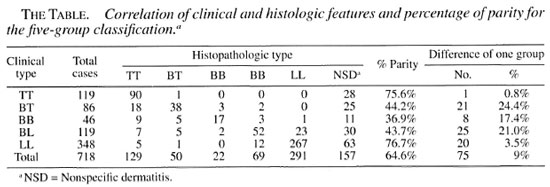- Volume 68 , Number 2
- Page: 184–5
Clinical and histopathological correlation in leprosy
To the Editor:
Histological examination of skin lesions is an important tool in the accurate classification of leprosy. Ridley and Jopling (3) laid down precise criteria for the histological typing of leprosy. However, a number of observers have noted disparity between the clinical diagnosis and histological diagnosis.
All 736 patients included in this study were taken from an urban leprosy center - Department of Dermatology, Dr. S.N. Medical College, Jodhpur, India. A clinical diagnosis of each case was made at the time of a visit and a skin biopsy was taken for histopathological examination. The criteria laid down by Ridley and Jopling were followed in both clinical and histological diagnoses.
Among the 736 patients biopsied at the time of registration, in 476 cases (64.7%) there was complete parity between clinical type and histologic type.
For the five-group (TT-LL) scale, the corresponding figures showed complete parity in 464 cases (64.6%) out of 718 cases (The Table). The two polar groups (LL and TT) showed complete agreement in 76.7% and 75.6%, respectively. In the borderline group, complete parity ranged between 37.0% for BB and 44.2% for BT.
There was minor disagreement (difference of one group) in 67 patients (9%) and major disagreement (difference of two or more groups) in 30 cases (4.1%), while the histology was not specific in 157 cases (21.9%). We observed highest parity in the LL and TT groups (76.7% and 75.6%, respectively), followed by BT (44.2%), BL (43.7%) and BB (37.0%).

Ridley and Jopling (3) in their study of 82 cases found complete agreement between clinical and histological type in 56 patients (68.3%), minor disagreement of one group in 21 patients (25.6%) and major disagreement of two or more groups in 5 patients (6%). In our study there was complete parity between clinical and histologic diagnosis in 64.7% of the cases, minor disagreement, 9%, and major disagreement, 4.1 %.
Sehgal, et al. (4), in a study of 95 patients, found complete agreement in only one third of the cases. In the present study, complete parity was higher (64.7%). In the remaining cases minor disagreement of one group was observed. Highest parity was observed for LL and BB followed by BL (42%), TT (33%) and BT (26.3%).
Dubey, et al. (1) in their study of 100 cases observed an overall parity of 89%. They found complete parity between clinical and histological diagnosis for BT and BL cases, i.e., 3 out of 3 and 2 out of 2, respectively. For tuberculoid leprosy, midborderline leprosy and lepromatous leprosy complete parity was found in 76%, 86% and 93.5%, respectively. In the rest of the cases a difference of one group was observed.
The Table. Correlation of clinical and histologic features and percentage of parity for the five-group classification."
Verma, et al. (5) in a study of 27 cases found 100% parity forTT (5 out of 5 cases) and BB (1 out of 1 case). The parity was only 40% for the BT and BB groups and 83% for LL cases.
Jerath and Desai (2) in a study of 130 cases found complete agreement in 89 cases (68.5%). The figures for individual groups were TT (74.5%), BT (64.7%), BB (53.8%), BL (28.5%), LL (61.5%) and indeterminate leprosy (88.8%).
The reasons for disparity are not well understood. Some of the differences could be due to the occurrence of reaction, or due to the type and site of lesion biopsied.
- G. Kalla, M.D., M.N.A.M.S.
Atul Salodkar, M.D.
Dilip Kachhawa, M.D.
Department of Dermatology, STD and Leprosy
Dr. S.N. Medical College
Jodhpur (Raj.), India
REFERENCES
1. Dubey, G. K., Joglekar, V. K., Grover, S. and Chaubey, B. D. Correlation of clinical and histopathological studies in classification of leprosy. Lepr. India 53 (1981) 562-565.
2. Jerath, V. P. and Desai, S. R. Diversities in clinical and histopathological classification of leprosy. Lepr. India 54 (1982) 130-134.
3. Ridley, D. S. and Jopling, W. H. Classification of leprosy according to immunity; a live-group system. Int. J. Lepr. 32 (1966) 255-273.
4. Sehgal, V. N., Rege, V. L. and Rege, H. Correlation between clinical and histopathological classification in leprosy. Int. J. Lepr. 45 (1977) 278-280.
5. Verma, K. C., Ganguli, D. D. and Jain, V. K. Applicability of Ridley-Jopling scale in clinical practice. Lepr. India 53 (1981) 556-561.
Reprint requests to Dr. G. Kalla, 4-F-12 New Power House Road, Jodhpur 342003, India.